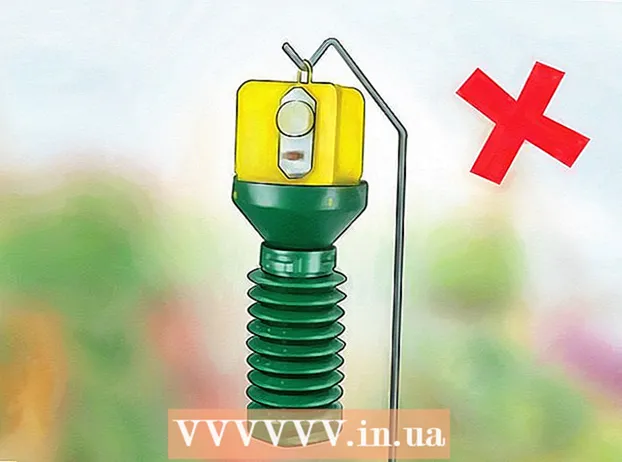Author:
Helen Garcia
Date Of Creation:
19 April 2021
Update Date:
1 July 2024

Content
- Steps
- Part 1 of 3: Treating and dressing minor wounds
- Part 2 of 3: Helping minor wounds heal
- Part 3 of 3: When to see a doctor
A minor abrasion, scratch, or shallow cut that doesn't bleed much can be healed at home with first aid. Go to the emergency room immediately if the wound is open, bleeding profusely, or deeper than 5–7 mm. Urgent medical attention is required if a person has a bruised (from a blow from a fallen or thrown heavy object), torn (from a blow with a metal object) or puncture wound, as well as a wound from an animal bite. The steps below will help you avoid infection and serious scars. If an open wound continues to bleed for 10-15 minutes, seek immediate medical attention.
Steps
Part 1 of 3: Treating and dressing minor wounds
 1 Wash your hands with soap. Be sure to wash your hands before touching an open wound. Wear medical gloves, if you have them. This will protect the wound from bacteria and germs on the hands.
1 Wash your hands with soap. Be sure to wash your hands before touching an open wound. Wear medical gloves, if you have them. This will protect the wound from bacteria and germs on the hands. - If you touch someone else's wound, wear medical gloves to protect your hands and prevent the spread of germs.
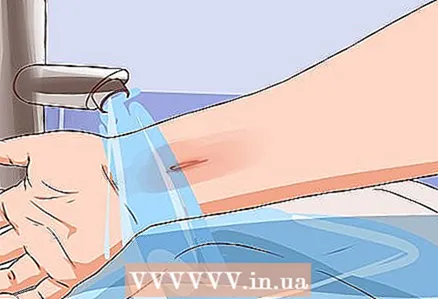 2 Rinse the wound under running water. Let the water wash away dirt and debris from the wound. When cleaning the wound, do not rub or pry open it to avoid further damage.
2 Rinse the wound under running water. Let the water wash away dirt and debris from the wound. When cleaning the wound, do not rub or pry open it to avoid further damage. 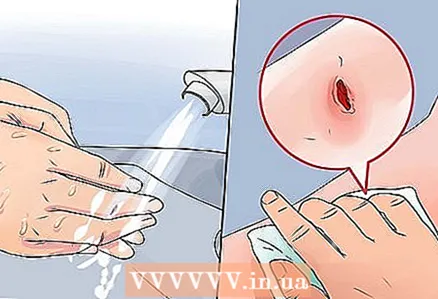 3 Stop bleeding with a clean, dry piece of cloth. Apply a clean, dry piece of tissue to the wound and apply gentle, even pressure with both hands until the bleeding stops. Minor wounds should stop bleeding within a few minutes.
3 Stop bleeding with a clean, dry piece of cloth. Apply a clean, dry piece of tissue to the wound and apply gentle, even pressure with both hands until the bleeding stops. Minor wounds should stop bleeding within a few minutes. - If the bleeding has not stopped after 10-15 minutes, you should seek medical attention. The wound may be too deep to be treated at home.
 4 Raise the wound above the level of the heart to slow the bleeding. If the wound is in a leg, foot, or toes, place your leg on a chair or pillows so that it is higher than your heart. If the wound is on an arm, palm, or fingers, lift it over your head to slow bleeding. If you injure your torso, head, or genital area, seek immediate medical attention.This is especially true for any head injuries - they must be examined by a doctor.
4 Raise the wound above the level of the heart to slow the bleeding. If the wound is in a leg, foot, or toes, place your leg on a chair or pillows so that it is higher than your heart. If the wound is on an arm, palm, or fingers, lift it over your head to slow bleeding. If you injure your torso, head, or genital area, seek immediate medical attention.This is especially true for any head injuries - they must be examined by a doctor. - If you lift the wound over your head and the bleeding does not stop for more than 10-15 minutes, seek medical attention.
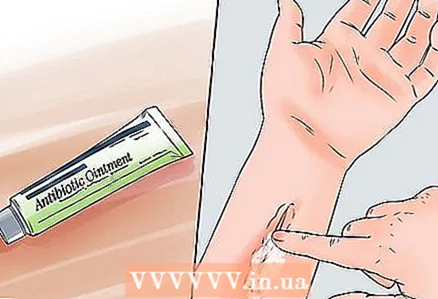 5 Apply an antibiotic ointment to the wound. Apply 1–2 coats of ointment to the wound and cover with gauze. This will help keep the wound free from infection and keep it moist, thereby speeding up healing.
5 Apply an antibiotic ointment to the wound. Apply 1–2 coats of ointment to the wound and cover with gauze. This will help keep the wound free from infection and keep it moist, thereby speeding up healing. - When applying the ointment to an open wound, do not apply too much pressure, especially if the damaged area is red or swollen.
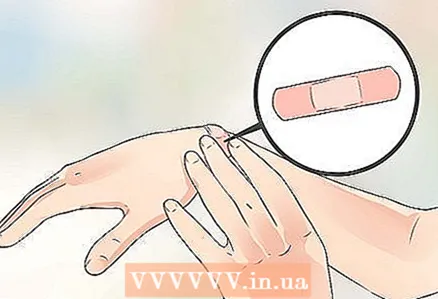 6 Cover up a small cut plaster. Cut a patch large enough to seal the cut.
6 Cover up a small cut plaster. Cut a patch large enough to seal the cut. 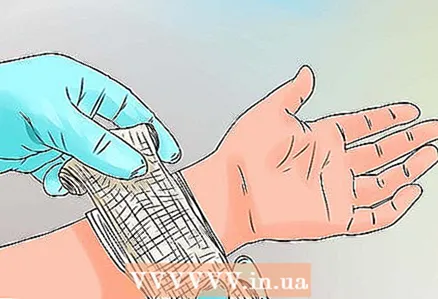 7 Bandage the abrasion or puncture wound with gauze. Take a piece of gauze large enough to cover the wound, or cut off the desired piece with clean scissors. Apply the piece to the wound and secure it with a medical fixation tape.
7 Bandage the abrasion or puncture wound with gauze. Take a piece of gauze large enough to cover the wound, or cut off the desired piece with clean scissors. Apply the piece to the wound and secure it with a medical fixation tape. - If you don't have gauze on hand, use a patch. The main thing is that it is large enough to cover the entire wound.
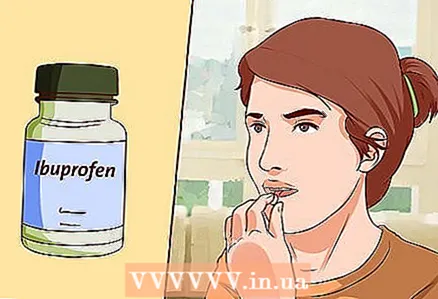 8 Take an over-the-counter pain reliever. An open wound can hurt and sore as it heals. Take paracetamol (Panadol) every 4-6 hours, or as directed in the instructions, to manage pain. Stick to the dosage indicated in the instructions for use and never exceed the recommended dosage.
8 Take an over-the-counter pain reliever. An open wound can hurt and sore as it heals. Take paracetamol (Panadol) every 4-6 hours, or as directed in the instructions, to manage pain. Stick to the dosage indicated in the instructions for use and never exceed the recommended dosage. - Do not take aspirin as it can cause bleeding.
Part 2 of 3: Helping minor wounds heal
 1 Change the bandage 3 times a day. Remember to wash your hands before changing the bandage. Remove the bandage in the direction of hair growth to avoid damaging the skin. If you notice that the crust has adhered to the bandage, soak the bandage with a solution of 1 teaspoon (5 ml) salt and 4 liters of water, or use sterile water (water for injection) if you have one at hand. Gently remove the bandage after a couple of minutes, when it is sufficiently wet.
1 Change the bandage 3 times a day. Remember to wash your hands before changing the bandage. Remove the bandage in the direction of hair growth to avoid damaging the skin. If you notice that the crust has adhered to the bandage, soak the bandage with a solution of 1 teaspoon (5 ml) salt and 4 liters of water, or use sterile water (water for injection) if you have one at hand. Gently remove the bandage after a couple of minutes, when it is sufficiently wet. - If the crust is still somewhere stuck to the bandage, wet it again until the bandage comes off. Do not pull or tug on the bandage to avoid damaging the wound and causing more bleeding.
- Be sure to apply antibiotic ointment to the wound before bandaging it again. This will keep it moist and heal faster. The ointment can also be applied to a bandage and then applied to the wound.
 2 Do not pick or scratch the wound. As the open wound begins to heal, it will itch and sore, especially when a crust begins to form on it. Refrain from picking, scratching, or rubbing the wound as this will slow down the healing process. Wear tight clothing and make sure that the wound is closed so you will not have the urge to touch it.
2 Do not pick or scratch the wound. As the open wound begins to heal, it will itch and sore, especially when a crust begins to form on it. Refrain from picking, scratching, or rubbing the wound as this will slow down the healing process. Wear tight clothing and make sure that the wound is closed so you will not have the urge to touch it. - To make the damaged area less itchy, you can apply an ointment to it, which will keep the surface of the wound moist.
 3 Do not apply strong antiseptic to the wound. Hydrogen peroxide, rubbing alcohol, and iodine are quite harsh drugs and can burn the skin tissue, which will harm it even more and may even lead to scarring. An antibiotic ointment is more than enough to keep the wound clean and sterile.
3 Do not apply strong antiseptic to the wound. Hydrogen peroxide, rubbing alcohol, and iodine are quite harsh drugs and can burn the skin tissue, which will harm it even more and may even lead to scarring. An antibiotic ointment is more than enough to keep the wound clean and sterile.  4 Make sure the wound is covered and bandaged. An open wound should not be exposed to air, as this will slow healing and lead to scarring. Make sure that the wound is always bandaged, especially if you are in the sun.
4 Make sure the wound is covered and bandaged. An open wound should not be exposed to air, as this will slow healing and lead to scarring. Make sure that the wound is always bandaged, especially if you are in the sun. - The bandage should only be removed while showering or bathing, as the moist environment is good for the wound.
- When the new skin covers the wound, the bandage can be removed. Bandage the wound to protect it during activities that might open the wound, such as playing sports.
Part 3 of 3: When to see a doctor
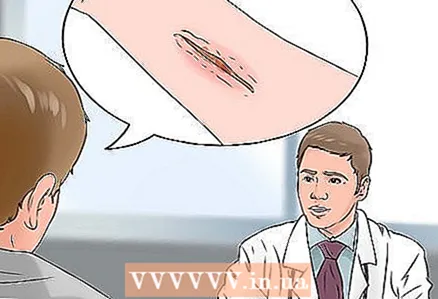 1 See your doctor if the wound is deeper than 5–7 mm. In order for a deep wound to heal properly, professional medical attention is needed (sometimes, such a wound needs to be stitched). Do not try to heal them at home, as this can lead to infection and scarring.
1 See your doctor if the wound is deeper than 5–7 mm. In order for a deep wound to heal properly, professional medical attention is needed (sometimes, such a wound needs to be stitched). Do not try to heal them at home, as this can lead to infection and scarring. 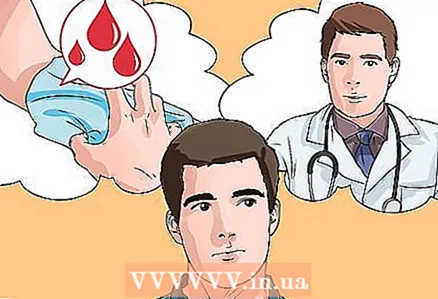 2 See your doctor if the wound still hasn't healed after 2–3 weeks. If the wound does not close or heal, it may be deeper than you thought, so seek medical attention. A trauma doctor or surgeon will examine the wound and provide the necessary assistance.
2 See your doctor if the wound still hasn't healed after 2–3 weeks. If the wound does not close or heal, it may be deeper than you thought, so seek medical attention. A trauma doctor or surgeon will examine the wound and provide the necessary assistance. 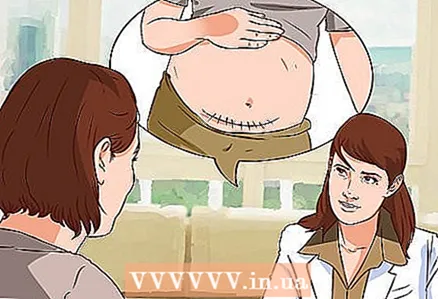 3 Seek medical attention if the wound seems to be infected, hot to the touch, red, swollen, or festering. See your doctor immediately if you notice signs of infection. Do not delay with treatment, or the infection may worsen. A wound can become infected if it:
3 Seek medical attention if the wound seems to be infected, hot to the touch, red, swollen, or festering. See your doctor immediately if you notice signs of infection. Do not delay with treatment, or the infection may worsen. A wound can become infected if it: - hot to the touch
- blushed
- swollen
- hurts,
- festered.
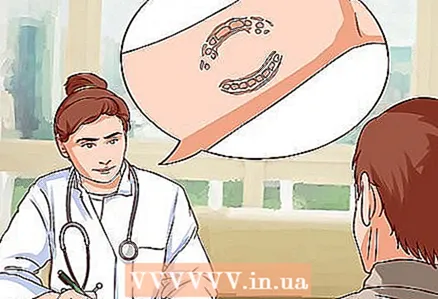 4 See your doctor if the wound is caused by an animal bite. All animal bites, regardless of their size, need to be examined by a doctor. The doctor will follow the protocol established for such cases by the health authorities.
4 See your doctor if the wound is caused by an animal bite. All animal bites, regardless of their size, need to be examined by a doctor. The doctor will follow the protocol established for such cases by the health authorities. - In case of animal bites (regardless of the degree of damage), the victim is usually prescribed an antibiotic course (for example, "Augmentin").
- If you have been bitten by a wild animal or pet that is not vaccinated against rabies, you will be given a course of rabies vaccinations.
 5 Let your doctor treat the wound. The doctor will examine the wound to see how serious it is. He may then suggest stitches to close the wound and speed up healing.
5 Let your doctor treat the wound. The doctor will examine the wound to see how serious it is. He may then suggest stitches to close the wound and speed up healing. - If the wound is small, the doctor may seal it with medical glue.
- If the wound is large and deep, he will sew it up with a needle and medical thread. You will have to return to the doctor's office after a week to remove the stitches.



